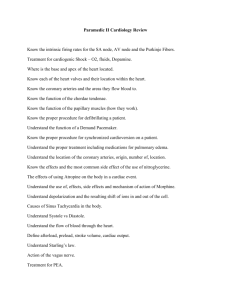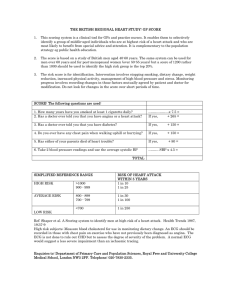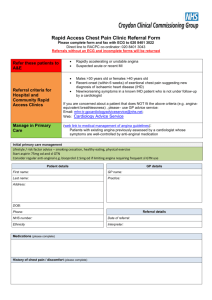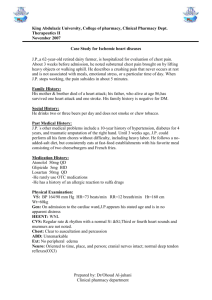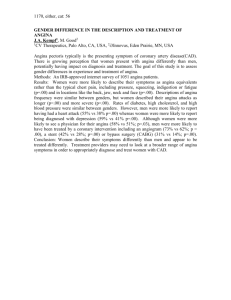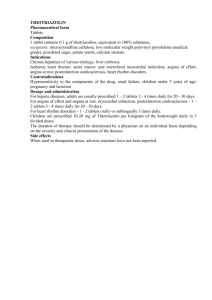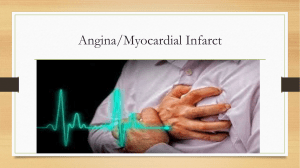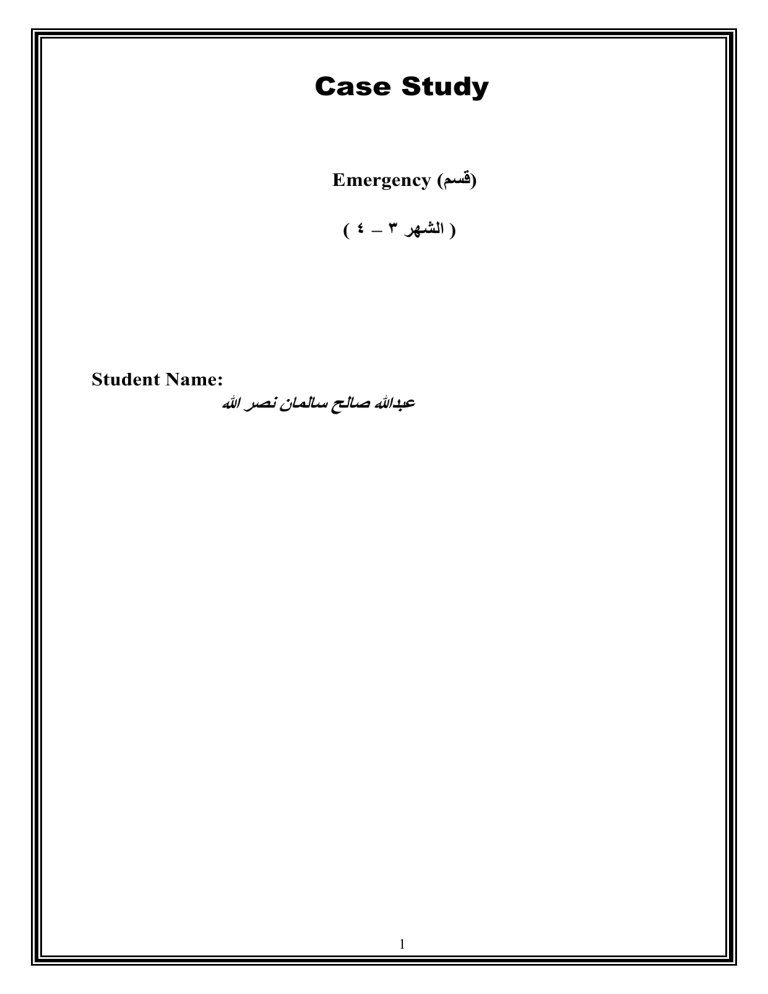
Case Study )قسم( Emergency ( الشهر ) ٤ – ٣ Student Name: عبدهللا صالح سالمان نصر هللا 1 Case Study Sociodemographic data Special unit : emergency Patient’s name: Heba Mostafa Ahmed. Date of admission: 22/4/2023 Stay period: 1 day Age:38 Sex: Female Level of education: Bechalor degree Occupation: Teacher Marital status: Married Religious: Muslim Present History: -Diagnosis/ Present illness: Angina -Chief complaints on admission: pain on chest and nausea -Predisposing factors: obesity, not enough exercise and high blood pressure -Reliving measures and its effect: Taking alot of rest , drinking plenty of water, exercise and lose weight Past History: Medical: (patient ha no medical history) -Diagnosis / Duration:…………………………………………………………………. Surgical: (patient has no surgical history) -Name of surgery / Duration:………………………………………………………….. Allergy history: (patient has no allergy history) Family history: -Diagnosis / Relation: Father had myocardial infarction (MI) at age 43 Life style habit : Diet rich in fats and carbohydrates, low-fiber diet, sedentary lifestyle, low physical activity, Patient’s physical assessment: Vital signs: Blood Pressure: 140/100 mmHg , Pulse: 76b/m, Temperature: 37.2C ,Respiratory rate is 16/minute General appearance: Conscious and oriented, facial grimace Skin: good skin integrity, skin is warm , good skin turgor. 2 Head: Hair is equal distributed, absence of dandruff and alopecia Eyes:Both eyes are normal able to move both eyes , good response to light source, no discharge Ears: No discharge, able to her sound clearly Nose: Pink nasal mucosa , no discharge Mouth: Pink oral mucosa, tongue and uvula in midline position, teeth are properly aligned without dentures Neck and throat: No tenderness noted, no palpable mass and lesion Chest and lungs: Thoraxic is symmetric on inspection, clear breath sound Cardiovascular: Normal heart sound , normal heart rate, Apical pulse is 88b/m Upper and lower extremities: Normal range of motion Abdomen: Bowel sounds are normal,on palpation abdomen is slightly enlarged, tenderness in the upper right portion. Genitourinary system: No discharge Gastrointestinal: No bowel obstruction present, abdominal pain present Neurologic : Patient is mentally alert and oriented , able to follow commands, no neurovascular deficit. Definition of disease: Angina is chest pain or discomfort that occurs when your heart doesn’t get as much blood and oxygen as it needs. In angina, the need for increased blood flow isn’t met for a short time. When increased demand for blood goes away, angina symptoms go away too Pathophysiology\ types: There are different types of angina. The type depends on the cause and whether rest or medication relieve symptoms. Stable angina. Stable angina is the most common form of angina. It usually happens during activity and goes away with rest or angina medication. Stable angina pain is predictable and usually similar to previous episodes of chest pain. The chest pain typically lasts a short time, perhaps five minutes or less. Unstable angina (a medical emergency). Unstable angina is unpredictable and occurs at rest. Or the angina pain is worsening and occurs with less physical effort. It's typically severe and lasts longer than stable angina, maybe 20 minutes or longer. The pain doesn't go away with rest or the usual angina medications. If the blood flow doesn't improve, the heart is starved of oxygen and a heart attack occurs. Unstable angina is dangerous and requires emergency treatment. Variant angina (Prinzmetal angina). Variant angina, also called Prinzmetal angina, isn't due to coronary artery disease. It's caused by a spasm in the heart's arteries that temporarily reduces blood flow. Severe chest pain is the main symptom of variant angina. It most often 3 occurs in cycles, typically at rest and overnight. The pain may be relieved by angina medication. Refractory angina. Angina episodes are frequent despite a combination of medications and lifestyle changes. Etiology According to patient According to literature 1- coronary arteries disease - reduced blood flow to the heart muscle 2- sedentary lifestyle and imbalance diet - Atherosclerosis, spasm of coronary arteries 3- plaques in a blood vessel rupture or a blood clot forms, it can quickly block reduce flow- Oxygen when decrease in blood flow through a narrowed artery. Clinical manifestations According to patient According to literature 1-Pain may also be felt in the arms - Squeezing 2- chest pain and discomfort - Fatigue,Nausea Shortness of breath 3- Stomach (abdominal) pain - Sweating 4- Nausea 5- Shortness of breath 4 Complications According to patient According to literature 1- Pain extending beyond the chest to the - Pressure, fullness or a squeezing pain in the shoulder, arm center of the chest that lasts for more than a few minutes 2- Increasing episodes of chest pain, Nausea and vomiting - Fainting,Impending sense of doom 3- Shortness of breath,Sweating. - Continued pain in the upper belly area (abdomen). Diagnostic measures Lab investigation: According to literature Lab Investigation According to patient Patient's Results Normal Range Hemoglobin (hb) 12.7g/dl 12-16.5g/dl HCT 42.6% 41-50% RBCs 4.3x10*12/L 4-5.9 x 10*12/L WBCs 19.800/L 4.5-11.0 × 109/L PLT 320.000 Glucose 109 mg/dL Potassium (k+) 4.1 mEq/L 150.00-450.000 /mcl less than 140 mg/dl 3.5-5 mmol/L 5 Nursing Considerations INR 1.2 1.1 or below CK-MB 2.12 ng/mL urea 25 mg/dL below 0.02 ng/mL 6 to 24 mg/dL creatinine 0.72 mg/dL total cholesterol 184 mg/dL triglycerides 54 mg/dL 0.59 to 1.04 mg/dL less than 200 mg/dL 150 (mg/dL) sodium(Na+) 136 mEq/L 135-145 mEq/L Radiological examination: According to literature Type of examination According to patient Check for what done The ECG at rest Patient's Results Nursing Considerations showed a sinus rhythm, a heart rate of 82 bpm, a PR interval of 160 ms, QRS duration of 110 ms, QT of 360 ms, left atrial enlargement Unsatisfactory CT scan Medical management according to patient No. Drug name Route Dose / FrequencyAction 1 2 Nitrates Aspirin sublingual 0.3-0.6 mg Oral 75to100mg 3 (Plavix) Oral 4 Propranolol IV Nursing Consideratio 75mg Vasodilation nonsteroidal antiinflammatory drug antiplatelet 1mg/mL Beta blocker 6 5 Verapamil 6 Normal IV Saline Glucose 5% IV 7 IV 500ml/tid calcium-channel blockers Solution 500ml/bd Solution Surgical management According to patient According to literature Non -coronary artery bypass graft (CABG) -coronary angioplasty and stent insertion 7 Nursing management According to patient According to literature - Assess patient's pain scale and perception- To identify onset , intensity and duration of pain - provide comfort measures (backrub, position change, environmental control) - Monitoring cardiac enzymes and ECG - Encourage deep breathing exercises - To reduce pain and provide relaxation - Teach divertional activities (listening to music) - To assist breath muscles - Monitor vital signs - To distract patient from pain - Administer pain medication per doctor 's order prior to activities of daily living - To identify intensity of pain - Manage chest pain and Bed rest - To relieve the pain - Provide oxygen and Administer aspirin and nitroglycerin - Place patient with head of the bed elevated at 45 degrees. -Make patient comfortable and Hook up to monitor and Obtain ECG -Provide oxygen - Management of hypertension if present - to improve sedentary lifestyle - Maximizes expansion of lungs to prevent respiratory complication - Provide clear liquids in small amount, and progress diet as tolerated -Administer aspirin and nitroglycerin - Elevate the head of bed, maintain low-Fowler’s position. - To maintain muscles function. - Monitoring Pulse oximetry,ECG, - To enhance patient's relaxation 8 Cardiac enzymes and Respiration and reduce the negative impact of the surrounding environment. -Listen to the chest for rales - see doctor if have Tachypnea, Dyspnea and Altered mental status - Initial exercise and balance diet - less anxiety or emotional stress 9
